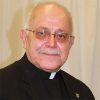“W ho do you say that I am?”
If you could go back to the time of Jesus, what would you see? The first challenge, of course, would be figuring out which one was Jesus. He wouldn’t be wearing the bright white, red and blue robes portrayed on holy cards. He would be wearing the same faded cotton or linen robes as everyone else. Without a halo, he’d look like so many other itinerant preachers, teachers and healers who perambulated the countrysides of Judea and Galilee.
And his name wouldn’t be Jesus! That’s the English translation of the Latin (by way of Greek) from the Hebrew Joshua, which in his native Aramaic was rendered Yahoshua, meaning “Yahweh saves.”
Contrary to what some believe, Christ is not Jesus’ last name. It means “the anointed,” that is, “the Messiah” or “king” and is the title for which he was crucified. But even a perfunctory reading of the Gospels shows that for those who encountered him, recognizing Jesus as the Messiah is a gradual, step-by-step process.
Lepers encountered Jesus as a healer, who delivered them from disease — and social isolation. Demoniacs experienced him as an exorcist who freed them from the power of evil.
At the synagogue on the Sabbath or listening to his Sermon on the Mount, people recognized him as a great preacher and teacher, Rabbi Jesus of Nazareth. At the Resurrection Mary Magdalene calls him “Rabboni” (my teacher and master).
But the title Jesus used most often for himself was “Son of Man.” The Gospels record Jesus using this reference no fewer than 80 times. That’s Bar Nasha in Aramaic or Ben Adam in Hebrew, both titles rich in meaning. At its basic level it means simply a human being, or a son of the human race. In the Book of Daniel, it refers to the one who comes to judge the human race at the end of the world.
The encounter between Jesus and the Samaritan woman at the well in John 4:4-30 shows a step-by-step recognition of who Jesus is. The woman sees him first as a man and a suspicious adversary. She thinks, “Why would a Jewish man talk to an unaccompanied Samaritan woman?” When Jesus tells her to go call her husband, she dissimulates, “I don’t have one.” Instead of chastising her for duplicity, Jesus praises her honesty. “You don’t have one. You’ve had five and the one you have now is not your husband,” he retorts.
In short order the Samaritan woman goes from calling Jesus a Jew to “sir,” “rabbi,” and finally, “Messiah.” This is one of only a few places in the Gospels where Jesus clearly admits he is the Messiah. And to a Samaritan woman, no less!
Each of the four Gospels lead us through different processes of discovery. Matthew reveals Jesus as the Messiah of the Jewish people. Luke proclaims him Savior of the whole world. For Mark, Jesus is the Son of God and for John, Jesus is present as the Word who was with God from the beginning. John’s Gospel makes clear that Jesus isn’t just the Son of God but God the Son (John 20:28).
Even non-Christians wrestle with the challenge of understanding who Jesus is. Hindus regard him a guru, but many consider him also an acharya, a spiritually advanced teacher whose life and teachings are one. Some even venerate him among their gods and mystics. Buddhists say Jesus is a bodhisattva, who postponed entering Nirvana so he could show others the way to Enlightenment. Islam numbers Jesus among the greatest of prophets, born of the Virgin Mary — to whom an entire chapter of the Quran is dedicated. They consider both Jesus and Mary as embodying characteristics of what it means to be Muslim, that is, one who surrenders to the will of God.
And you? Who do you say Jesus is?
More importantly, does your life reflect your answer?
Featured Image: An image of Christ is pictured at the entrance of New Mexico’s historic El Santuario de Chimayo shrine, renowned for its soil’s legendary healing properties. (Bob Roller/CNS/U.S.)
![]()

